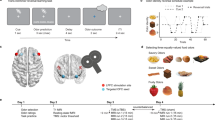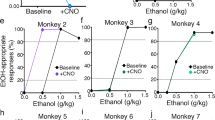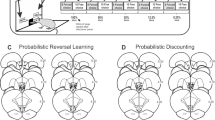Abstract
To study how the interaction between orbitofrontal (OFC) and rhinal (Rh) cortices influences the judgment of reward size, we reversibly disconnected these regions using hM4Di-DREADD (designer receptor exclusively activated by designer drug). Repeated inactivation reduced sensitivity to differences in reward size in two monkeys. These results suggest that retrieval of relative stimulus values from memory depends on the interaction between Rh and OFC.
This is a preview of subscription content, access via your institution
Access options
Subscribe to this journal
Receive 12 print issues and online access
$209.00 per year
only $17.42 per issue
Buy this article
- Purchase on Springer Link
- Instant access to full article PDF
Prices may be subject to local taxes which are calculated during checkout



Similar content being viewed by others
References
Clark, A.M., Bouret, S., Young, A.M., Murray, E.A. & Richmond, B.J. J. Neurosci. 33, 1833–1845 (2013).
Armbruster, B.N. et al. Proc. Natl. Acad. Sci. USA 104, 5163–5168 (2007).
Minamimoto, T., La Camera, G. & Richmond, B.J. J. Neurophysiol. 101, 437–447 (2009).
Van Essen, D.C. & Maunsell, J.H. J. Comp. Neurol. 191, 255–281 (1980).
Diester, I. et al. Nat. Neurosci. 14, 387–397 (2011).
Brooks, V. in Reviews of Physiology, Biochemistry and Pharmacology, Vol. 95 (eds. Adrian, R.H. et al.) 1–109 (Springer Berlin Heidelberg, 1983).
Martin, J.H. & Ghez, C. J. Neurosci. Methods 86, 145–159 (1999).
Haber, S.N., Kim, K.S., Mailly, P. & Calzavara, R. J. Neurosci. 26, 8368–8376 (2006).
Rizzo, M.A., Springer, G.H., Granada, B. & Piston, D.W. Nat. Biotechnol. 22, 445–449 (2004).
Krashes, M.J. et al. J. Clin. Invest. 121, 1424–1428 (2011).
Lerchner, W., Corgiat, B., Der Minassian, V., Saunders, R.C. & Richmond, B.J. Gene Ther. 21, 233–241 (2014).
Han, X. et al. Neuron 62, 191–198 (2009).
Liu, Z., Murray, E.A. & Richmond, B.J. Nat. Neurosci. 3, 1307–1315 (2000).
Meunier, M., Bachevalier, J., Mishkin, M. & Murray, E.A. J. Neurosci. 13, 5418–5432 (1993).
Fritz, J., Mishkin, M. & Saunders, R.C. Proc. Natl. Acad. Sci. USA 102, 9359–9364 (2005).
Turchi, J., Saunders, R.C. & Mishkin, M. Proc. Natl. Acad. Sci. USA 102, 2158–2161 (2005).
Wang, P. & Nikolic´, D. Front. Hum. Neurosci. 5, 85 (2011).
Hays, A.V. et al. WESCON Conference Proceedings, 1–10 (1982).
Bowman, E.M., Aigner, T.G. & Richmond, B.J. J. Neurophysiol. 75, 1061–1073 (1996).
Myers, R.H. et al. Generalized Linear Models: with Applications in Engineering and the Sciences (Wiley, 1995).
Simmons, J.M., Minamimoto, T., Murray, E.A. & Richmond, B.J. J. Neurosci. 30, 15878–15887 (2010).
Rosene, D.L. et al. J. Histochem. Cytochem. 34, 1301–1315 (1986).
Walker, A.E. J. Comp. Neurol. 73, 59–86 (1940).
Barbas, H. & Pandya, D.N. J. Comp. Neurol. 286, 353–375 (1989).
Pandya, D.N. & Yeterian, E.H. Prog. Brain Res. 85, 63–94 (1990).
Carmichael, S.T. & Price, J.L. J. Comp. Neurol. 363, 615–641 (1995).
Acknowledgements
We thank A. Cummins, M. Malloy, E. Masseau, A. Horovitz, K. Lowe, J. Fredericks, B. Corgiat, S. Bhayana, and V. Der Minassian for their technical assistance. This study was supported by the Intramural Research Program of the National Institute of Mental Health (M.A.G.E., W.L., R.C.S. and B.J.R.), the Intramural Research Program of the National Cancer Institute (K.W.K., F.J.G.), PRESTO/JST and KAKENHI 15H05917 (T.M.).
Author information
Authors and Affiliations
Contributions
M.A.G.E., W.L., R.C.S. and B.J.R. designed the study. W.L. produced virus. R.C.S., W.L. and M.A.G.E. performed surgery. M.A.G.E. and B.J.R. analyzed the behavioral data. R.C.S., W.L., B.J.R. and M.A.G.E. analyzed the histological data. K.W.K. and F.J.G. analyzed serum and CSF samples. H.K., B.J., M.H. and T.M. performed and analyzed in vitro experiments. M.A.G.E., W.L., R.C.S., T.M. and B.J.R. wrote the manuscript.
Corresponding author
Ethics declarations
Competing interests
The authors declare no competing financial interests.
Integrated supplementary information
Supplementary Figure 1 CNO-induced silencing of neurons in vitro and serum and CSF concentrations in vivo.
(A) Representative extracellular spike trains from hM4Di-CFP sample before CNO (baseline), 20 min after bath application of CNO solution (CNO; 1 μM) and subsequent washout with fresh medium without CNO (washout). (B) Population firing rate of hM4Di-expressing neurons. Asterisk indicates statistical significance on Welch's t-tests with a Bonferroni correction for multiple comparisons; * p < 0.05. (C) and (D) same as (A) and (B), respectively, but following GPF vector application. (E) Time series analysis of cerebrospinal fluid (CSF) levels of CNO following i.m. dose. Administration of CNO was repeated three times in a single monkey (Monkey G). Gray shaded region indicates test session durations for Monkeys D and S. (F and G) Measurement of serum (F) and CSF (G) concentrations of clozapine-N-oxide (‘CNO’), N- desmethylclozapine (‘NDMC’)(A.K.A. Norclozapine), and clozapine (‘Cloz’) in 10 monkeys, from samples extracted 60 min after i.m. CNO injection. Grey bars represent group mean.
Supplementary Figure 2 Reaction times and mean trials completed.
Reaction times were unaffected by administration of CNO (10 mg/kg i.m.) (ANOVA; monkey D: main effect of treatment, F(1,3) = 0.20, p > 0.05, monkey S: treatment, F(1,4) = 1.80, p > 0.05). (A) Reaction times of monkey D, (B) Reaction times of monkey S. Mean trials completed in each session, and mean reward earned were also unaffected (ANOVA; all p > 0.05) (C) mean rewards earned per session by monkey D, and (D) mean rewards earned per session by monkey S.
Supplementary Figure 3 Control injections and effects of CNO dose and route of administration on reward valuation.
(A) CNO (10 mg/Kg) administered prior to viral transduction of OFC did not alter behavior in monkey S (LME; treatment, z = 1.45, p > 0.05, treatment x reward size, z = -0.16, p > 0.05). (B) Injection of vehicle after OFC transduction did not alter the performance of monkey D (LME; treatment, z = 0.23, p > 0.05, treatment x reward size, z = -1.48, p > 0.05). (C) Injection of 1 mg/Kg CNO did not alter the performance of monkey D (LME; treatment, z = 2.22, p > 0.05, treatment x reward size, z = -1.02, p > 0.05). (D) Injection of 5 mg/Kg CNO reduced discrimination between drop sizes without altering overall error rate in monkey D (LME; treatment, z = 1.28, p > 0.05, treatment x reward size, z = -2.76, p < 0.05). (E and F) Subcutaneous CNO (10mg/Kg) administration produced comparable effects to i.m. CNO administration in both monkey S (E) and monkey D (F) (c.f. Fig 2).
Supplementary Figure 4 Histological analysis of expression area coverage.
(A) Brodmann regions 11, 13 and 14 were outlined on each available section using the Carl Zeiss ZEN software on a tile composite confocal 5x image stained for CFP (green) and NeuN (red). Airy units were set to capture a 30 μm optical section. The software determined the sizes of outlined regions. (B) Expression area analysis. Expression areas were defined by outlining regions of somatic neuronal expression on a tile composite confocal 20x image using the Carl Zeiss ZEN software. Airy units were set to capture a 20-μm section. Five metrics were determined for each expression area: 1) area covered by outline, 2) ‘length’ of expression area (determined by largest dimension) (a), 3) ‘width’ of expression area (a measure taken perpendicular to length) (b), 4) distance of center of expression area from cortical surface along the length axis (c), and 5) thickness of cortex along the axis of expression area length (d). (C) Population measures for expression areas analyzed in Monkey D. Groups of cortical layers were assigned the following way: superficial layers: 0% < c/d <33%, middle layers: 33% < c/d < 66%, and deep layers: 66% < c/d < 100%. (D) Population measures for expression areas analyzed in Monkey S. (E-G) Analysis of penetrance in expression areas at the level of single neurons. (E) A 1002 μm grid was placed over each the centre expression area on a 20x confocal section, oriented parallel to the length axis (a). To determine neuronal penetrance, all NeuN expressing cells were counted in a particular square and then all NeuN cells colocalized with cellular CFP expression were counted and divided by the total number of NeuN expressing cells in the 100 μm square. (F) Plot of mean percentage in aligned expression area grid squares. The four squares at the center of the expression areas (outlined by a black square) had a median neuronal penetrance of approximately 60%. (G) Plot of maximum percentage in aligned expression area grid squares. The four 100 μm squares surrounding the middle of all expression areas (outlined by a black square) had a maximum neuronal penetrance of 100%.
Supplementary Figure 5 Reconstructions of rhinal lesions.
Rh lesions shown on a ventral view of the macaque brain, and on coronal slices at the indicated levels, for monkey D (blue, left hemisphere) and monkey S (red, right hemisphere).
Supplementary information
Supplementary Text and Figures
Supplementary Figures 1–5 and Supplementary Table 1 (PDF 1162 kb)
Rights and permissions
About this article
Cite this article
Eldridge, M., Lerchner, W., Saunders, R. et al. Chemogenetic disconnection of monkey orbitofrontal and rhinal cortex reversibly disrupts reward value. Nat Neurosci 19, 37–39 (2016). https://doi.org/10.1038/nn.4192
Received:
Accepted:
Published:
Issue Date:
DOI: https://doi.org/10.1038/nn.4192
This article is cited by
-
Characterization of DREADD receptor expression and function in rhesus macaques trained to discriminate ethanol
Neuropsychopharmacology (2022)
-
Chemogenetic inactivation reveals the inhibitory control function of the prefronto-striatal pathway in the macaque brain
Communications Biology (2021)
-
Effect of chemogenetic actuator drugs on prefrontal cortex-dependent working memory in nonhuman primates
Neuropsychopharmacology (2020)
-
Emergence of abstract rules in the primate brain
Nature Reviews Neuroscience (2020)
-
Deschloroclozapine, a potent and selective chemogenetic actuator enables rapid neuronal and behavioral modulations in mice and monkeys
Nature Neuroscience (2020)



